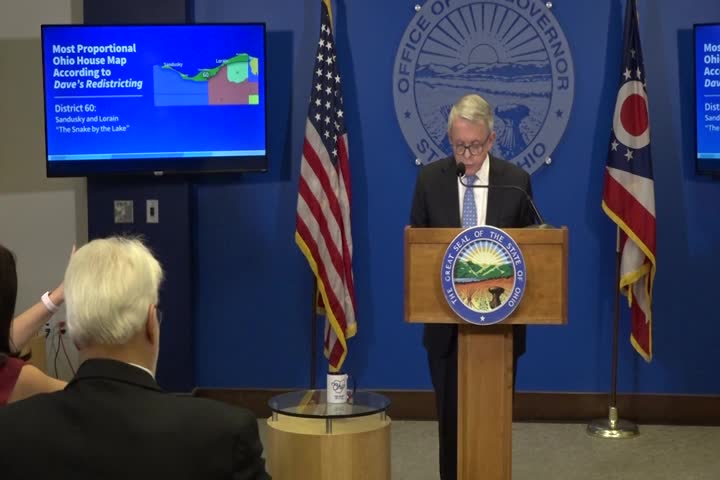Gerrymandering Exposed in Ohio's Controversial Redistricting Map
July 31, 2024 | Governor Mike DeWine, Office of the Governor , Executive Offices, Organizations, Executive , Ohio

This article was created by AI summarizing key points discussed. AI makes mistakes, so for full details and context, please refer to the video of the full meeting. Please report any errors so we can fix them. Report an error »

In a recent government meeting, officials scrutinized the implications of a newly proposed redistricting map for Ohio, highlighting concerns over gerrymandering and community fragmentation. The map, which aims to achieve proportional representation, has drawn criticism for its convoluted district shapes and the splitting of numerous communities.
Key discussions centered on District 60, which connects Sandusky and Lorraine, and was likened to the notorious \"snake by the lake\" district, albeit on a smaller scale. Critics pointed out that this design serves a predetermined partisan outcome, undermining the integrity of local governance.
Further examination revealed that Districts 15 and 24 in Western Cuyahoga County exhibit similar issues, with District 15 described as \"scooped out\" from District 24, resulting in unnecessary splits of communities such as Bay Village and Rocky River. The fragmentation extends to Eastern Cuyahoga County, where multiple cities, including Cleveland and its suburbs, are divided among several districts, raising alarms about the dilution of local representation.
The meeting also addressed the Toledo area, where District 85 splits Sylvania and connects it to parts of Wood and Henry Counties, resulting in a fragmented representation for Henry County. In the Mahoning Valley, District 66 splits both Youngstown and Warren, while District 87 in the Miami Valley divides Springfield into three separate districts.
The map was presented as a citizen-drawn effort aimed at proportionality, achieving a perfect score on a redistricting analysis. However, officials argued that the pursuit of proportionality has led to extreme gerrymandering, with the proposed constitutional amendment further exacerbating these issues by prioritizing proportionality over community integrity.
The meeting concluded with a call for a reevaluation of the redistricting process, emphasizing the need for maps that respect community boundaries and promote effective governance rather than partisan advantage. As the debate continues, the implications of these district designs will be closely monitored by constituents and advocacy groups alike.
Key discussions centered on District 60, which connects Sandusky and Lorraine, and was likened to the notorious \"snake by the lake\" district, albeit on a smaller scale. Critics pointed out that this design serves a predetermined partisan outcome, undermining the integrity of local governance.
Further examination revealed that Districts 15 and 24 in Western Cuyahoga County exhibit similar issues, with District 15 described as \"scooped out\" from District 24, resulting in unnecessary splits of communities such as Bay Village and Rocky River. The fragmentation extends to Eastern Cuyahoga County, where multiple cities, including Cleveland and its suburbs, are divided among several districts, raising alarms about the dilution of local representation.
The meeting also addressed the Toledo area, where District 85 splits Sylvania and connects it to parts of Wood and Henry Counties, resulting in a fragmented representation for Henry County. In the Mahoning Valley, District 66 splits both Youngstown and Warren, while District 87 in the Miami Valley divides Springfield into three separate districts.
The map was presented as a citizen-drawn effort aimed at proportionality, achieving a perfect score on a redistricting analysis. However, officials argued that the pursuit of proportionality has led to extreme gerrymandering, with the proposed constitutional amendment further exacerbating these issues by prioritizing proportionality over community integrity.
The meeting concluded with a call for a reevaluation of the redistricting process, emphasizing the need for maps that respect community boundaries and promote effective governance rather than partisan advantage. As the debate continues, the implications of these district designs will be closely monitored by constituents and advocacy groups alike.
View full meeting
This article is based on a recent meeting—watch the full video and explore the complete transcript for deeper insights into the discussion.
View full meeting
